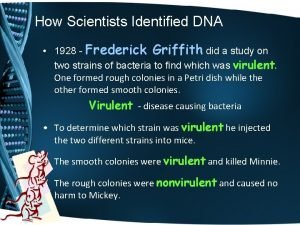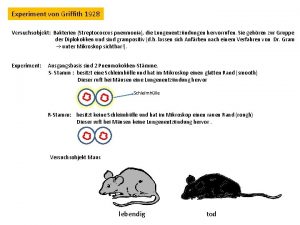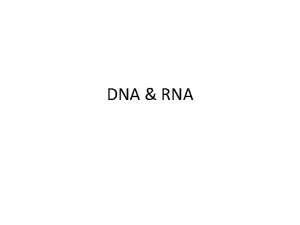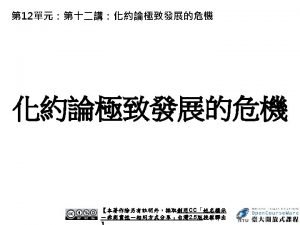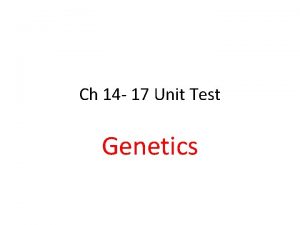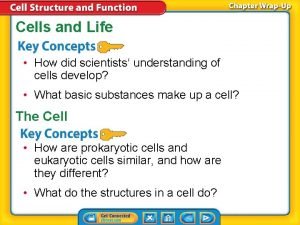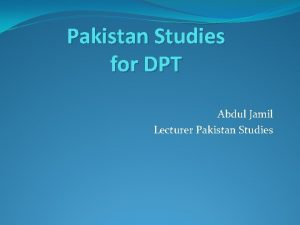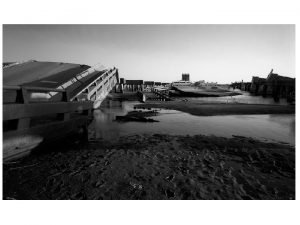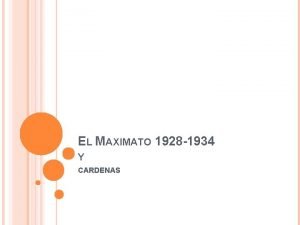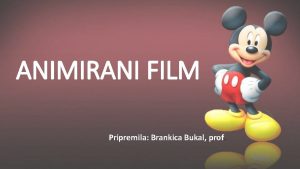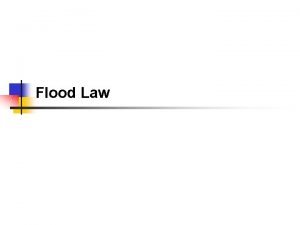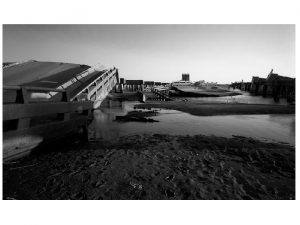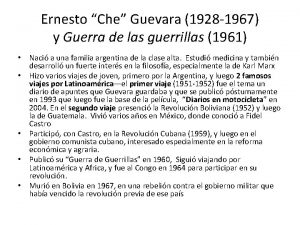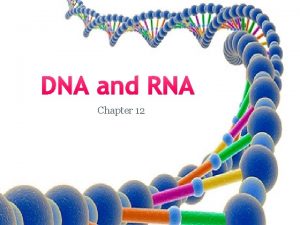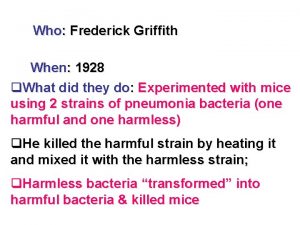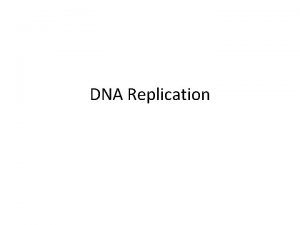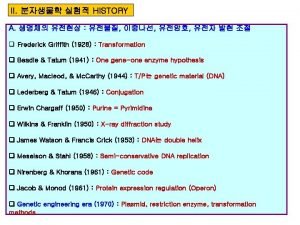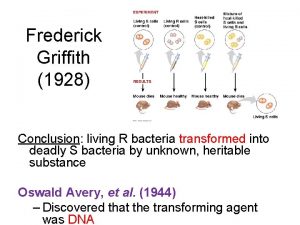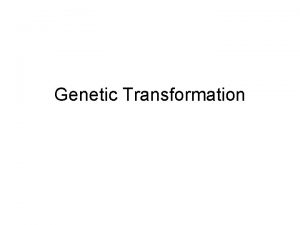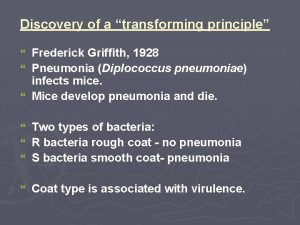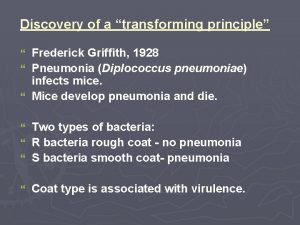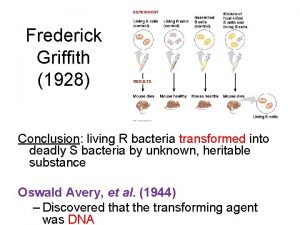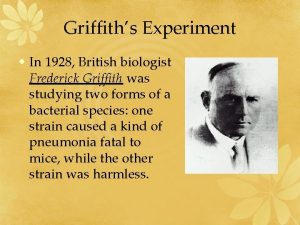How Scientists Identified DNA 1928 Frederick Griffith did

















- Slides: 17

How Scientists Identified DNA • 1928 - Frederick Griffith did a study on two strains of bacteria to find which was virulent. One formed rough colonies in a Petri dish while the other formed smooth colonies. Virulent - disease causing bacteria • To determine which strain was virulent he injected the two different strains into mice. • The smooth colonies were virulent and killed Minnie. • The rough colonies were nonvirulent and caused no harm to Mickey.

• In the next part of the study, Griffith killed the virulent bacteria with heat. When this strain was injected into a mouse it caused no harm. • He then mixed the heat killed virulent bacteria with the nonvirulent strain. When this mix was injected into a mouse, the mouse died • in the mix there were no nonvirulent bacteria. Only virulent bacteria was present. • What happened? Why was the only bacteria present virulent?


What happened? Why was the only bacteria present virulent? • Griffith concluded that the nonvirulent strain had taken something from the virulent strain. At the time Griffith did not know what that something was. • Transformation is the process in which a bacterium takes up foreign DNA • The rough colonies had taken up the smooth colonies DNA

Oswald Avery wanted to continue Griffith’s work. Was it DNA or protein that made the nonvirulent strain of bacteria turn virulent? Experiment #1 Avery extracted (took out) DNA from bacteria in the smooth colony and added it to bacteria in the rough colony. The bacteria that grew from the mixture formed smooth colonies. Experiment #2 Avery added protein-destroying enzymes to the bacteria, but transformation still took place. Experiment #3 Avery added DNA -destroying enzymes to the bacteria, and transformation did not take place. What could he conclude?

It was clear to Avery that DNA was the genetic material in the bacteria!!! Many of his colleagues still held on to the belief that protein was the genetic material.

• Alfred Hershey and Martha Chase performed an experiment using viruses that infect bacteria by attaching to the surface of the cell and injecting hereditary information like tiny hypodermic needles. • This way hundreds of new viruses are produced. • These viruses have a very simple structure: a core of DNA surrounded by a protein coat.


Hershey and Chase did experiments to determine if DNA held the hereditary information They did experiments with radioactive labels. One experiment used virus with radioactive sulfur and another used a virus with radioactive phosphorus. They infected two batches of bacteria and gave the virus time to attach to the bacteria and inject their hereditary material. The protein coating detached from the original bacteria, but not from the new. The DNA stayed the same in both the new and the original.

• DNA was the clear winner.

DNA structure • • DNA is composed of subunits called nucleotides. A nucleotide is comprised of 3 parts: – A sugar, called deoxyribose – A phosphate group – And a base • The sugar and phosphate group are the same in every nucleotide, but the base can be one of four types.

• The 2 larger bases, adenine and guanine, are called purines. • The 2 smaller bases, cytosine and thymine, are called pyrimidines.

Erwin Chargaff made a stunning discovery – later known as Chargaff’s rules • The amount of adenine always equals the amount of thymine. A = T • The amount of guanine always equals the amount of cytosine. G = C • This suggests a regularity in the composition of DNA

DNA resembles a tightly coiled spring, a spiral staircase • Double helix – a spiral staircase composed of two strands of nucleotides whose bases face each other. • The nucleotides pair up in a regular order: – Adenine faces thymine – Guanine faces cytosine • A sugar phosphate backbone makes the sides of the Double helix.

Watson and Crick’s model of DNA • James Watson and Francis Crick built the first model of a DNA double helix. • They followed the clues of Chargaff’s rules and X-ray diffraction photograph done by Rosalind Franklin, a London chemist. • Watson and Crick were awarded the Nobel Prize in 1963 for their development of this model


 Griffith
Griffith Frederick griffith 1928
Frederick griffith 1928 Griffith 1928
Griffith 1928 Rna
Rna Scientists show dna from
Scientists show dna from In his transformation experiments what did griffith observe
In his transformation experiments what did griffith observe Alexander miles invention
Alexander miles invention How did scientists understanding of cells develop
How did scientists understanding of cells develop Nehru report
Nehru report Flood control act of 1928
Flood control act of 1928 Cuadro comparativo del maximato
Cuadro comparativo del maximato 1928 magnetic tape
1928 magnetic tape Parobrod willy 1928
Parobrod willy 1928 Flood control act of 1928
Flood control act of 1928 Flood control act of 1928
Flood control act of 1928 1967-1928
1967-1928 1928 flood control act
1928 flood control act Ariel 1928
Ariel 1928

